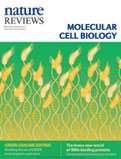|
| TABLE OF CONTENTS | |||||||||||||||||||||||||||||||||||||||||
| May 2018 Volume 19 Number 5 | Advertisement | ||||||||||||||||||||||||||||||||||||||||
| In this issue
|
| |||||||||||||||||||||||||||||||||||||||
| |||||||||||||||||||||||||||||||||||||||||
 | |||||||||||||||||||||||||||||||||||||||||
| Advertisement | |||||||||||||||||||||||||||||||||||||||||
| |||||||||||||||||||||||||||||||||||||||||
| Comment: The future of CRISPR technologies in agriculture Caixia Gao p275 | doi:10.1038/nrm.2018.2 Conventional plant breeding is unlikely to meet increasing food demands and other environmental challenges. By contrast, CRISPR technology is erasing barriers to genome editing and could revolutionize plant breeding. However, to fully benefit from the CRISPR revolution, we should focus on resolving its technical and regulatory uncertainties. Caixia Gao outlines the technical, regulatory and public opinion hurdles for the future use of CRISPR technologies in plant breeding. Full Text | PDF | |||||||||||||||||||||||||||||||||||||||||
| |||||||||||||||||||||||||||||||||||||||||
| Advertisement | |||||||||||||||||||||||||||||||||||||||||
| |||||||||||||||||||||||||||||||||||||||||
| REVIEWS | Top | ||||||||||||||||||||||||||||||||||||||||
| Understanding the diversity of membrane lipid composition Takeshi Harayama & Howard Riezman p281 | doi:10.1038/nrm.2017.138 Membrane lipids exhibit a remarkable diversity — they vary in structure and chemical properties, and their distribution between different membranes and their subcompartments is highly heterogeneous. Recent progress in studies of membrane lipids has broadened our understanding of how this diversity affects membrane properties and membrane-associated processes. Abstract | Full Text | PDF | Supplementary information | |||||||||||||||||||||||||||||||||||||||||
| Once and only once: mechanisms of centriole duplication and their deregulation in disease Erich A. Nigg & Andrew J. Holland p297 | doi:10.1038/nrm.2017.127 Most eukaryotic cells contain a single centrosome with a pair of centrioles, which duplicate before mitosis. Defects in duplication lead to aberrant numbers of centrioles and centrosomes. Recent insights into mechanisms of centriole biogenesis and centriole number control are helping us to better understand the links between aberrant centrosome number and human disease. Abstract | Full Text | PDF | |||||||||||||||||||||||||||||||||||||||||
| Mechanisms of clathrin-mediated endocytosis Marko Kaksonen & Aurélien Roux p313 | doi:10.1038/nrm.2017.132 Clathrin-mediated endocytosis is the main mechanism for internalization of cell-surface molecules and surface-bound cargoes. Although the machineries that drive the formation of endocytic vesicle are intricate, an understanding of endocytosis is being unravelled at the molecular level. Abstract | Full Text | PDF | |||||||||||||||||||||||||||||||||||||||||
| A brave new world of RNA-binding proteins Matthias W. Hentze, Alfredo Castello, Thomas Schwarzl & Thomas Preiss p327 | doi:10.1038/nrm.2017.130 Recent proteome-wide studies have uncovered hundreds of RNA-binding proteins (RBPs) that lack conventional RNA-binding domains. These RBPs instead use intrinsically disordered regions, protein-protein interaction interfaces and enzymatic cores to bind RNA. Interestingly, some RBPs are regulated by RNA rather than regulate RNA. Abstract | Full Text | PDF | Supplementary information | |||||||||||||||||||||||||||||||||||||||||
| Advertisement | |||||||||||||||||||||||||||||||||||||||||
| |||||||||||||||||||||||||||||||||||||||||
| |||||||||||||||||||||||||||||||||||||||||
| You have been sent this Table of Contents Alert because you have opted in to receive it. You can change or discontinue your e-mail alerts at any time, by modifying your preferences on your nature.com account at: www.nature.com/myaccount For further technical assistance, please contact our registration department For print subscription enquiries, please contact our subscription department For other enquiries, please contact our feedback department Springer Nature | One New York Plaza, Suite 4500 | New York | NY 10004-1562 | USA Springer Nature's worldwide offices: Macmillan Publishers Limited is a company incorporated in England and Wales under company number 785998 and whose registered office is located at The Campus, 4 Crinan Street, London, N1 9XW. © 2018 Macmillan Publishers Limited, part of Springer Nature. All Rights Reserved. |
 |









No comments:
Post a Comment